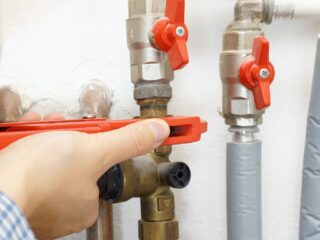
House repiping is when all the water pipes in a home are replaced with new ones. This is usually done when pipes are old and might cause problems like leaks or poor water quality. It’s a big job but can make a home’s water system work better and safer.
Repiping a house is a major project that requires careful planning and execution. It involves replacing all the water pipes in a home, which can be a daunting task for homeowners. This guide aims to understand everything you need to know about house repiping.
Recognizing When Your House Needs Repiping
Knowing when it’s time to consider house repiping is crucial in avoiding disastrous consequences later on. While minor issues can often be fixed easily, some signs indicate an aging or failing plumbing system which may require repiping:
Persistent Leaks Despite Frequent Repairs
Persistent leaks despite frequent repairs are a warning sign that your home may need a plumbing upgrade. These leaks can lead to bigger problems like mold and water damage if not addressed. Over time, fixing leaks repeatedly becomes more expensive than replacing your pipes.
Leaks can happen in old pipes because they get weak or rusty. When you fix a leak, but another one appears soon after, it means your pipes are too old. A plumbing upgrade can solve this by putting in new pipes that won’t leak as easily.
Unusual Noises in Your Pipes (Banging or Clattering Sounds)
Unusual noises in your pipes, like banging or clattering, can be surprising. These sounds often occur when water flow and pressure aren’t consistent. Addressing this issue can be an important part of home renovation.
When your pipes make these sounds, it might mean they are hitting each other or parts of your house. This can happen because supports that hold pipes in place have gotten loose over time. Fixing these supports and checking the water pressure can help stop the noise.
Discolored or Foul-Smelling Water
Discolored water coming from your taps may mean your pipes are old or rusty. If the water looks brown, yellow, or has any strange color, it’s a sign you might need new pipes. This is not only bad to look at but can also be unhealthy to drink or use.
When your water smells bad, it’s a big warning sign. Water should not have a smell. If it smells like rotten eggs or metal, this could mean there is something wrong inside your pipes that needs fixing right away.
Fluctuating or Consistently Low Water Pressure
Fluctuating or consistently low water pressure means the water doesn’t flow as strongly as it should. This can happen if your pipes are clogged, leaking, or just old and worn out. When water doesn’t come out fast or strong, it can make simple tasks like taking a shower or washing dishes frustrating.

If your home has low water pressure all the time, it might be time to check your pipes. Old or damaged pipes can’t carry water well, which is why pressure drops. Getting new pipes can help make your water flow strong and steady, just like it’s supposed to.
Choosing the Right Material for Your Pipes
When it comes to repiping your home, you have several options for plumbing materials. Here are three of the most common:
Copper Pipes
Copper pipes are popular for home plumbing. They last a long time and are good at handling high water pressure. They don’t rust, which means your water stays clean.
However, copper can be expensive c
PEX Pipes
PEX pipes are relatively new in the market but have gained popularity in recent years. They’re made of flexible plastic and are easier to install compared to other materials. PEX pipes don’t corrode or rust, making them a durable option for repiping your home.
Galvanized Steel Pipes
Galvanized steel pipes were commonly used in homes built before the 1960s. These pipes are durable, but over time, they can corrode and rust, leading to leaks and poor water quality. If your home has galvanized steel pipes, it’s best to consider repiping them with a more modern material.
Steps Involved in House Repiping
The process of repiping a house typically involves the following main steps:
Initial Inspection and Planning
The initial inspection and planning phase is very important in the house repiping process. A professional plumber will come to your home to check all the pipes and see what needs to be done and how much it will cost. They will look at how the pipes are laid out, what materials they’re made of, and if there are any big problems like leaks or rust.
Removal of Old Pipes
The removal of old pipes is a key step in the repiping process. This part involves taking out all the pipes that are old, damaged, or don’t work right anymore. Workers might need to open walls or floors to get to the pipes, which can cause a bit of mess and noise in your home.
Installation of New Pipes
The installation of new pipes begins once the old ones are fully removed. This step is crucial for ensuring your home’s water flow is efficient and safe. Experienced plumbing services use the latest tools and techniques to fit new pipes, making sure they are properly connected and secured.
Testing for Leaks
After the new pipes are installed, professionals check for any potential leaks. This is an important step because even a small leak can cause damage over time and lead to costly repairs in the future.
Restoring Disrupted Areas
Once all the pipes are replaced and tested for leaks, it’s time to restore any areas that were disrupted during the repiping process. This could involve repairing walls, floors, or ceilings that were opened up for access to the pipes.
Securing Your Home’s Future with House Repiping
House repiping sounds like a big project, but it’s worth it. It makes your water clean, keeps your house safe, and avoids leaks. Think of it as a health check for your home.

When you choose to do house repiping, you’re picking a smarter future for your place. It stops bad smells and weird noises from pipes. Your showers and sinks will work better than before.
If you find this article helpful, check out our blog for more informative content.





